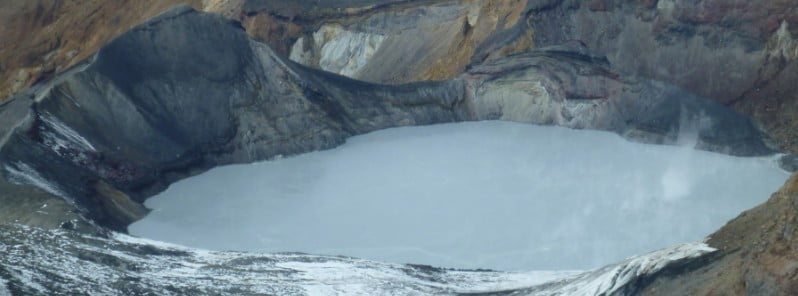Heightened volcanic unrest continues at Ruapehu with high volcanic gas output, strong tremor and steam plumes

High levels of volcanic gas emissions and strong volcanic tremor continue at New Zealand’s Ruapehu volcano. The Crater Lake (Te Wai ā-moe) temperature has risen to 41 °C (105.8 °F) and steam plumes can be observed in cold, still atmospheric conditions. The volcano is still at a heightened level of unrest. The Volcanic Alert Level remains at 2, with greater chances of eruption over the next four weeks than at Volcanic Alert Level 1.
Steam plumes were observed over Mt Ruapehu’s Crater Lake (Te Wai ā-moe) last week and observation flights have confirmed these steam plumes were not caused by an eruption. Instead, they were related to a combination of increased heat flow at the crater lake and still, cold atmospheric conditions.
Over the last 12 days, the Crater Lake temperature has peaked at 41 °C (105.8 °F) following a four-week period at 36 – 38 °C (96.8 – 100.4 °F). Modeling suggests that maintaining the lake temperature and recent rise has required ~300 – 400 MW of heat energy.
“Since early March, we have been recording strong volcanic tremor at Mt Ruapehu. This is the most sustained and vigorous volcanic tremor recorded in two decades, and it accompanied the rise in crater lake temperature. Although tremor levels remain high, there has been a decline in the tremor this last week,” GeoNet’s Duty Volcanologist Brad Scott said.1
Overall, the period of heightened volcanic unrest continues, Scott said.
Within the next four weeks, the most likely outcome of this unrest episode is minor eruptive activity that is confined to the lake basin, or no eruptions.
This level of activity may generate lahars (dangerous volcanic mudflows) in the Whangaehu River.
The next most likely scenario is a larger eruption that impacts the summit plateau with volcanic surges and generates lahars in multiple catchments, like what was seen after the September 2007 eruption, or older events like those in 1975 and 1969. An eruption of this size would cause life-threatening hazards on the summit plateau and in valleys impacted by lahars.
The chance of a prolonged eruptive episode or a larger eruption, such as occurred in 1995-96 with wider ashfall impacts, is higher than it was two months ago, but within the next 4 weeks remains very unlikely. Such an eruption would most likely only follow a sequence of smaller eruptions.
Due to the heightened volcanic unrest, GNS Science staff are carrying out more frequent aerial observations, gas measurements and Crater Lake sampling.
A gas measurement flight on May 4, 2022, confirmed high sulfur dioxide (SO2) and carbon dioxide (CO2) fluxes, respectively of 260 and 1 970 tonnes per day of gas. Both gases are indicator gases derived from relatively shallow magma bodies.
Observations from the gas flight and 2 additional observation flights have confirmed upwelling of central vent and northern vent areas continues. Further flights will be conducted when weather conditions are suitable.
The high sulphur dioxide (SO2) and carbon dioxide (CO2) gas output and sustained strong volcanic tremor, continue to indicate that molten rock (magma) is driving this period of heightened unrest.
Increasing Crater Lake temperature is reflecting the increasing upwelling of hot fluids and gases through the active vents. Available laboratory analysis of the latest Crater Lake fluid and gas samples show high temperatures in the hydrothermal system but no reaction with the magmatic material.
The observational data and activity is consistent with elevated volcanic unrest at the heightened level and therefore the Volcanic Alert Level remains at Level 2 and the Aviation Color Code at Yellow.
Geological summary
Ruapehu, one of New Zealand’s most active volcanoes, is a complex stratovolcano constructed during at least four cone-building episodes dating back to about 200 000 years ago.
The 110 km3 (26.4 mi3) dominantly andesitic volcanic massif is elongated in a NNE-SSW direction and surrounded by another 100 km3 (24 mi3) ring plain of volcaniclastic debris, including the Murimoto debris-avalanche deposit on the NW flank.
A series of subplinian eruptions took place between about 22 600 and 10 000 years ago, but pyroclastic flows have been infrequent. A single historically active vent, Crater Lake, is located in the broad summit region, but at least five other vents on the summit and flank have been active during the Holocene.
Frequent mild-to-moderate explosive eruptions have occurred in historical time from the Crater Lake vent, and tephra characteristics suggest that the crater lake may have formed as early as 3 000 years ago. Lahars produced by phreatic eruptions from the summit crater lake are a hazard to a ski area on the upper flanks and to lower river valleys.2
References:
1 Heightened volcanic unrest continues at Mt Ruapehu with volcanic gas output, strong tremor and steam plumes: Volcanic Alert Level remains at Level 2. – GeoNet – May 11, 2022
2 Ruapehu – Geological summary – GVP
Featured image credit: GeoNet

Commenting rules and guidelines
We value the thoughts and opinions of our readers and welcome healthy discussions on our website. In order to maintain a respectful and positive community, we ask that all commenters follow these rules:
We reserve the right to remove any comments that violate these rules. By commenting on our website, you agree to abide by these guidelines. Thank you for helping to create a positive and welcoming environment for all.